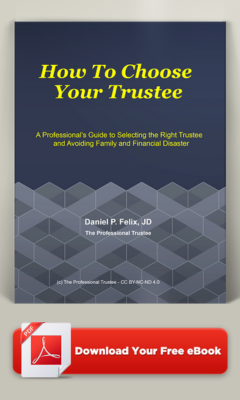What’s Preparation Got To Do With It?
It’s easy to understand how the culture and even many professionals think that there’s nothing for the successor trustee to do until the grantor is unable to act.
After all, the grantor is doing just fine handling his money and family and the rest of his life, thank you very much. It’s only when he can no longer act that he wants someone to step in.
And the instructions are set out in his documents, aren’t they?
And the grantor is quite clear on how things fit together.
Isn’t that more than enough?
On closer inspection, however, a different picture emerges.
This attitude is perhaps a bit like saying there’s nothing firemen can do until there’s a fire. Nothing as to fire codes, fire detectors and fire drills.
Or, perhaps better, it’s a bit like saying there’s no point tending to your health, until you’re sick. The foundational importance of preventive screenings as well as of practicing a healthy lifestyle of exercise and diet expose the fallacy of that thought.
You get the point: we should be asking about what is the value of preparation— especially as to the unique universe of successful trust administration, which relies on three overlapping, essential parts:
First, there’s trust administration itself. That’s the management, execution, and coordination around multiple disciplines. Investment, taxes, law and money management are a few of the key hard technical components.
We hear constantly about the benefits of planning in each of these disciplines. Especially in a trust, where these tasks are tightly involved, the trustee’s advance involvement save time, trouble and even money versus figuring it out in the time of crisis.
Second, there’s the foundation of the grantor’s vision. The trust is to take care of things the way the grantor wants. And, at the time the successor trustee becomes active, the grantor is no longer available for consultation. Yet, typically the vision is expressed only in the trust document itself, which is an imperfect guide, giving at best a financial and legal skeleton written in legalese, devoid of heart, vision and soul, and worse with no advice on how to deal with the myriad of unforeseen events which the future inevitably brings.
To remedy these known issues, the successor trustee can harvest and store in advance of need some of the wisdom, legacy, values and vision of the grantor.
Finally, there’s the beneficiary, who is the end-consumer of the trust. All too typically the beneficiary engages with the trust at the worst possible time: only after the loss of the grantor, which is too often also the peak of the beneficiary’s ignorance about the workings of the trust as well as the height of his emotional volatility resulting from that loss.
And if there are multiple beneficiaries, they typically have no experience working together. This common perfect storm scenario likely accounts for the many fractured families, including the skyrocketing number of trust-related lawsuits.
Perhaps there’s not much that can be done about the beneficiaries’ emotions, but certainly we can address ignorance and inexperience in advance.
In short, on closer inspection all three of the elements of active trust administration benefit from attention in advance of the grantor’s disability and death.
So, what does preparation have to do with it? Just about everything to make the trust a success!
Photo of Magnifying Glass by Markus Winkler on Unsplash© 2017 – 2023 Daniel P. Felix, all rights reserved.


